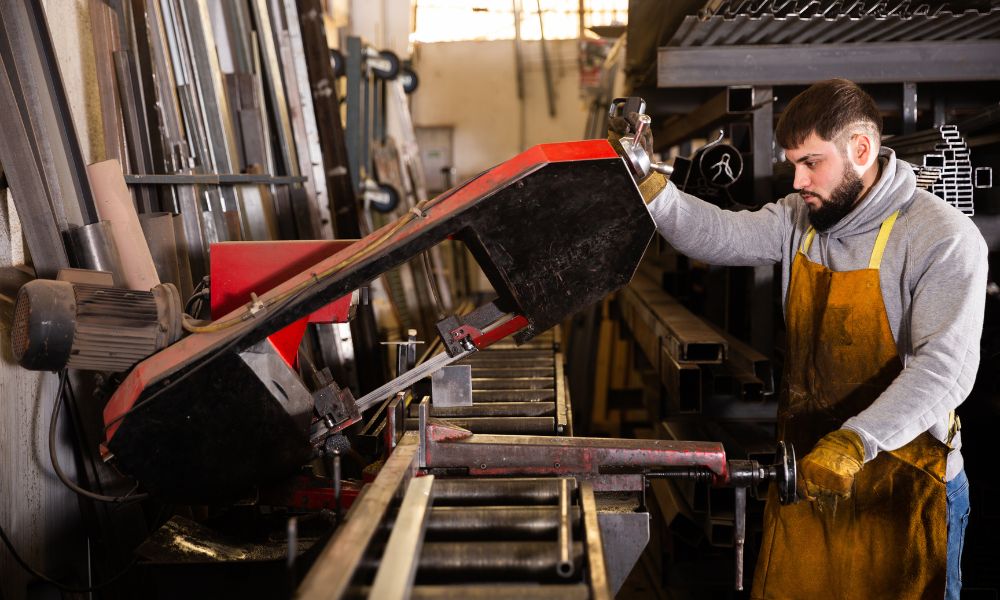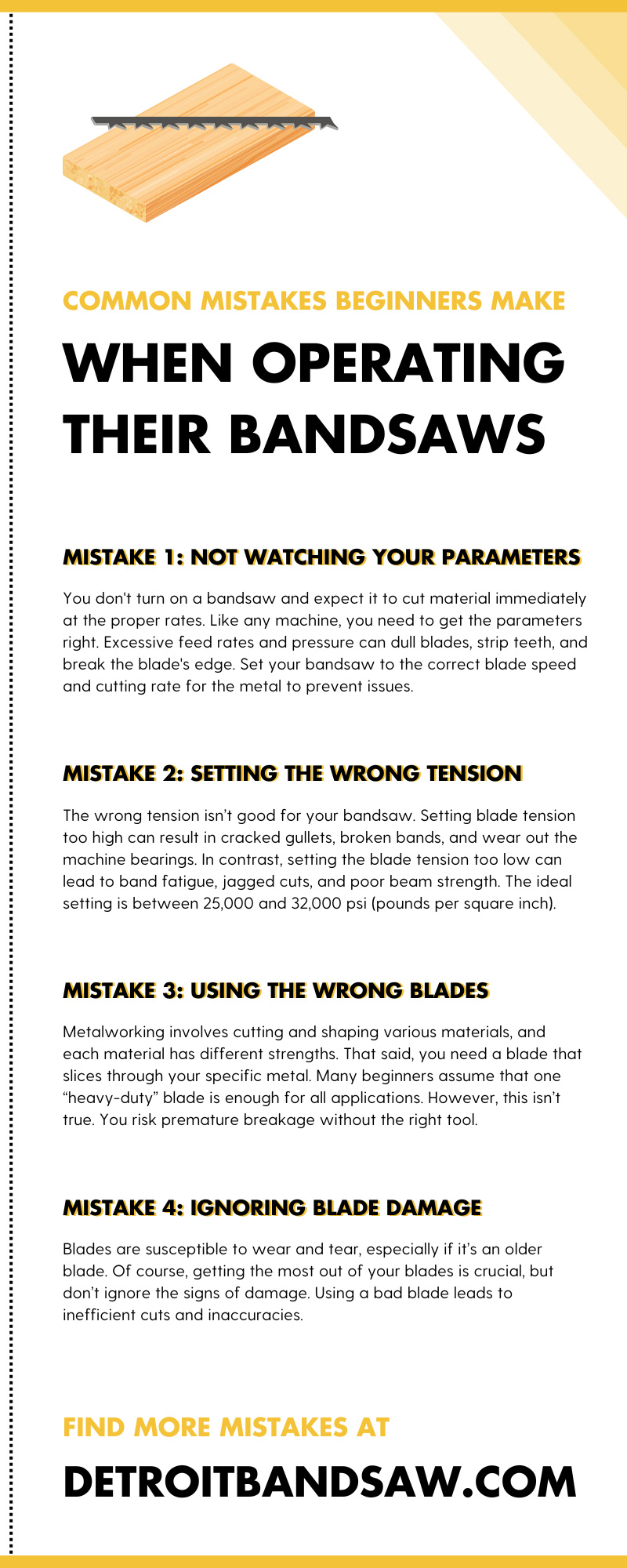Everyone learns from their mistakes, including metalworkers. In this case, we have bandsaw blunders you should avoid. Check out these mistakes beginners make when operating their bandsaws to prevent future problems.
Mistake 1: Not Watching Your Parameters
You don’t turn on a bandsaw and expect it to cut material immediately at the proper rates. Like any machine, you need to get the parameters right. Excessive feed rates and pressure can dull blades, strip teeth, and break the blade’s edge.
Set your bandsaw to the correct blade speed and cutting rate for the metal to prevent issues. As a good rule, use slow speeds for tougher materials and increase the speed for softer materials.
Check your operator’s manual for a feed rate chart for specific information. You want to avoid overworking the equipment and causing unnecessary wear and tear.
Mistake 2: Setting the Wrong Tension
The wrong tension isn’t good for your bandsaw. Setting blade tension too high can result in cracked gullets, broken bands, and wear out the machine bearings. In contrast, setting the blade tension too low can lead to band fatigue, jagged cuts, and poor beam strength.
The ideal setting is typically between 25,000 and 32,000 psi (pounds per square inch) but check your owner’s manual for recommended setting. You can use a gauge to measure and set the correct tension. Be sure to set the tension before operating the machine.
Mistake 3: Using the Wrong Blades
Metalworking involves cutting and shaping various materials, and each material has different strengths. That said, you need a blade that slices through your specific metal.
Many beginners assume that one “heavy-duty” blade is enough for all applications. However, this isn’t true. You risk premature breakage without the right tool. For help, here’s a quick rundown of blades:
Bi-Metal – Also known as M42 blades, bi-metals cover the broadest range of sawing applications and materials. They handle various types of steel, mixed-metal applications, and pipes/tubing. They’re reliable with excellent fatigue.
Carbide – Ideal for demanding applications like hardened steels, high-nickel alloys, titanium, composite graphite, and other exotic metals. Carbides cut materials that other blades can’t handle. They have high wear resistance.
Carbon Hardback – A part of the carbon steel blade family, hardbacks cut mild steels, copper, cast iron, plastic, brass, and non-ferrous metals. Hardbacks have heat-treated teeth and back, allowing you to use higher cutting rates and increased feed rates.
Carbon Flexback – Like hardbacks, the blades are perfect for mild steels, copper, cast iron, plastic, brass, and non-ferrous metals. Flexbacks have heat-treated teeth, giving them a flexible back and making them ideal for contour cuts. They’re good blades for woods, plastics and foams.
Portable – Manufacturers use bi-metal blades for portable band saw blades. They make them small enough for portable/handheld band saw machines. They can cut copper, angled iron, galvanized pipes, stainless steel, and other materials. Portable band saw blades have a long blade life.
Mistake 4: Ignoring Blade Damage
Blades are susceptible to wear and tear, especially if it’s an older blade. Of course, getting the most out of your blades is crucial, but don’t ignore the signs of damage. Using a bad blade leads to inefficient cuts and inaccuracies. Check out these ways to know you’ve reached the maximum lifespan:
- You begin to produce inaccurate cuts in workpieces.
- There are cracks and fractures on the blade.
- You have dull blades that cut slower.
- The blades make a loud, squeaky noise while cutting metals.
Mistake 5: Adjusting the Saw While It’s Running
Another mistake beginners make when operating their bandsaws is adjusting the machine while it’s running. This is the quickest way to injure your hand and damage your workpiece. Even the tiniest adjustment can have dangerous consequences.
Stay safe and produce accurate projects by powering off the machine before making adjustments. Once everything is back on track, you can continue cutting metals.
Mistake 6: Failing To Check the Fluids
Before operating the machine, you’ll apply cutting fluids to the bandsaw blades. They cool and lubricate the blade, making it easier to slice material. Some fluids require water before application, and you need to check the requirements for your solution. Additionally, make it a habit to check the fluids to ensure there aren’t any leaks. Most fluids evaporate as you operate the machine, so replace solutions when needed.
Mistake 7: Forgetting To Break in Blades
You can only use a new blade after you break it in first. Think of a new blade as a freshly sharpened pencil, where the tip breaks if you apply too much pressure. With bandsaw blades, failing to remove the sharp edge will cause stripped or crooked teeth.
Set the blade to the manufacturer’s recommended speed to properly break it in. Then, reduce the feed pressure to 50 percent of its normal rate.
This process extends blade life and improves overall performance. We also suggest keeping a record of your blades by writing down the day you break in the tool.
Mistake 8: Not Maintaining a Proper Stance
When you’re unfamiliar with the equipment, it’s easy to lean on machines to ensure you produce accurate results. That’s why beginner metalworkers often lean on bandsaws to see progress. However, that’s the last thing you want to do.
If you lean against blades, your body weight will push material too hard and fast through the machine. You’re more likely to create the wrong cuts. Furthermore, you may fall forward and injure yourself on the bandsaw.
Avoid this problem by maintaining a balanced stance over the bandsaw. Plant your feet solidly on the ground, position your hands to ensure they’re not near the blades, and slowly guide workpieces into the machine.
Mistake 9: Failing To Inspect the Machine
Inspections are a part of preventative maintenance. Before operating the machine, evaluate the bandsaw and blade appearance. Be aware of broken parts, teeth stripping, leaks, or worn-out blade guides. If you suspect problems, don’t use the machine. If you notice blade damage, replace the tool. Do what’s best for the machine.
Mistake 10: Brushing Off Safety Protocols
Lastly, brushing off safety protocols is a significant bandsaw mistake. Operating heavy equipment requires care and attention because it keeps you safe and ensures accurate workpieces. Many beginners bring the right gear, like safety goggles, eye protection, and appropriate footwear. However, they forget to be mindful of their clothes and hair.
When operating a bandsaw, don’t wear loose-fitting clothes or jewelry. If you have long hair, you must tie it back. Clothes, dangling accessories, and hair can catch onto the machine and pull you in, resulting in injuries. Assess your outfit and ask yourself, “can anything on my body catch onto the machine?” If the answer is yes, remove it.
For machines and blades, don’t rush through projects or start work before assessing the equipment. You don’t want any malfunctions or avoidable injuries! Safety is always the top priority whether you’re a beginner or an experienced metalworker.
Learn from the best and purchase superior products from Detroit Bandsaw. We carry bi-metal band saw blades, among other exceptional items. For helpful information, check out our posts about maintenance, band saw uses, and metalworking tips.

